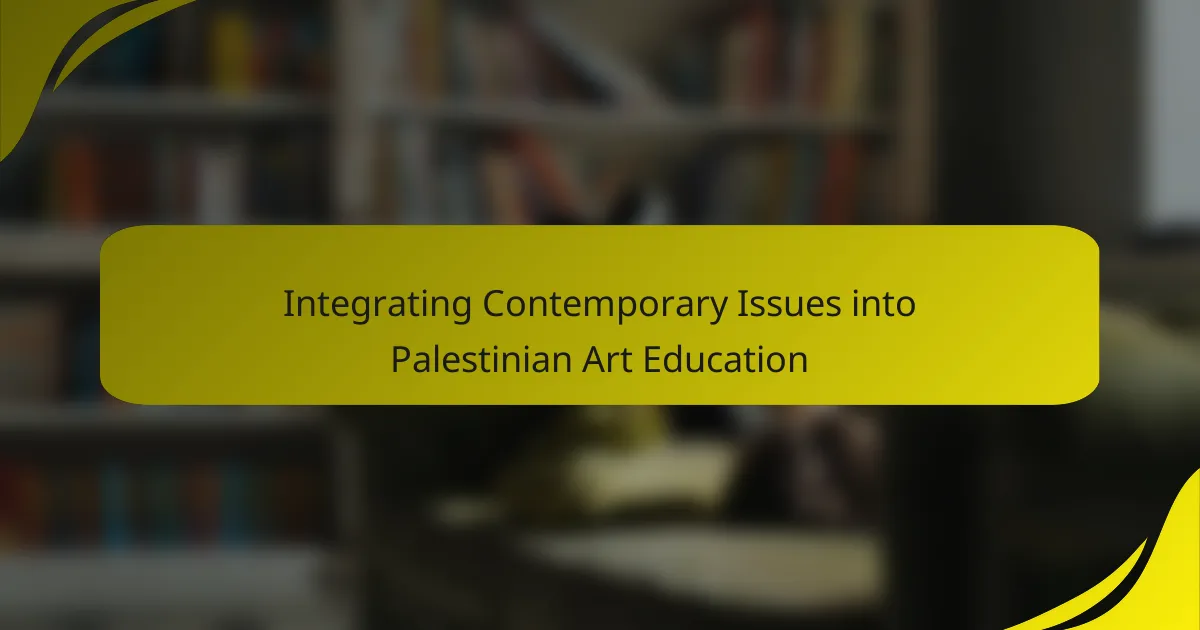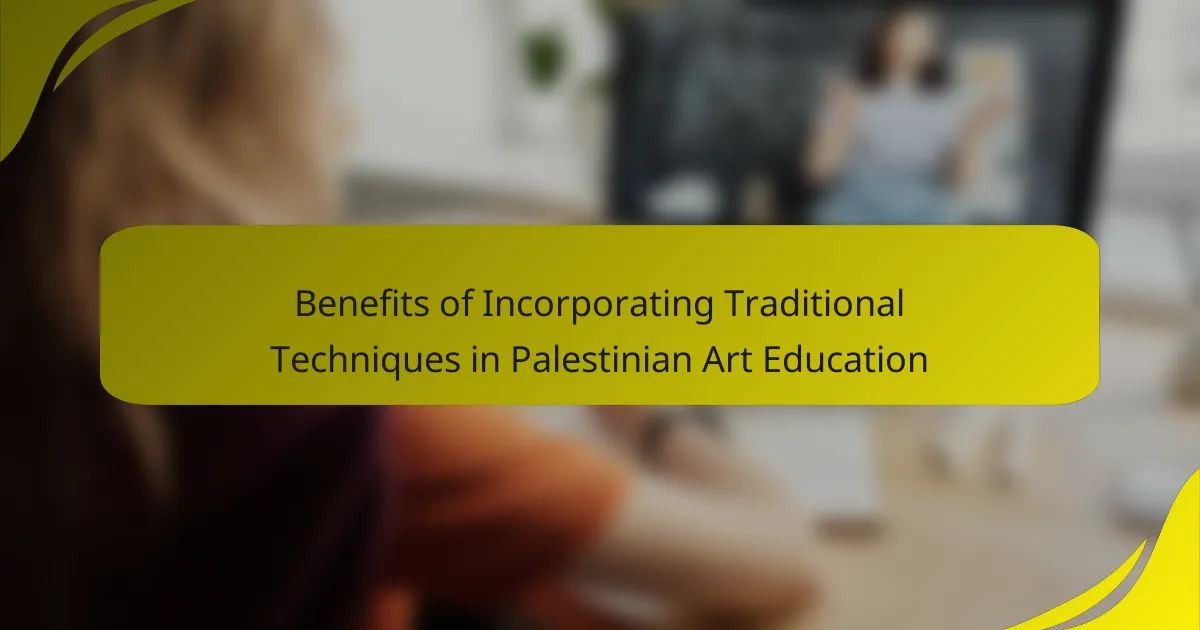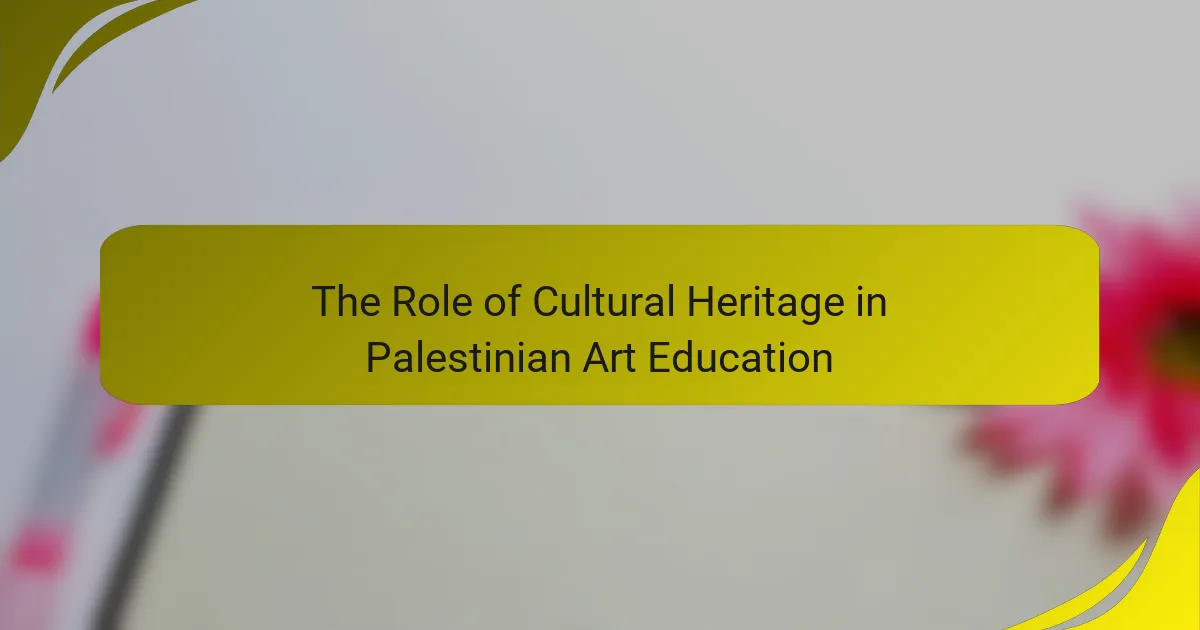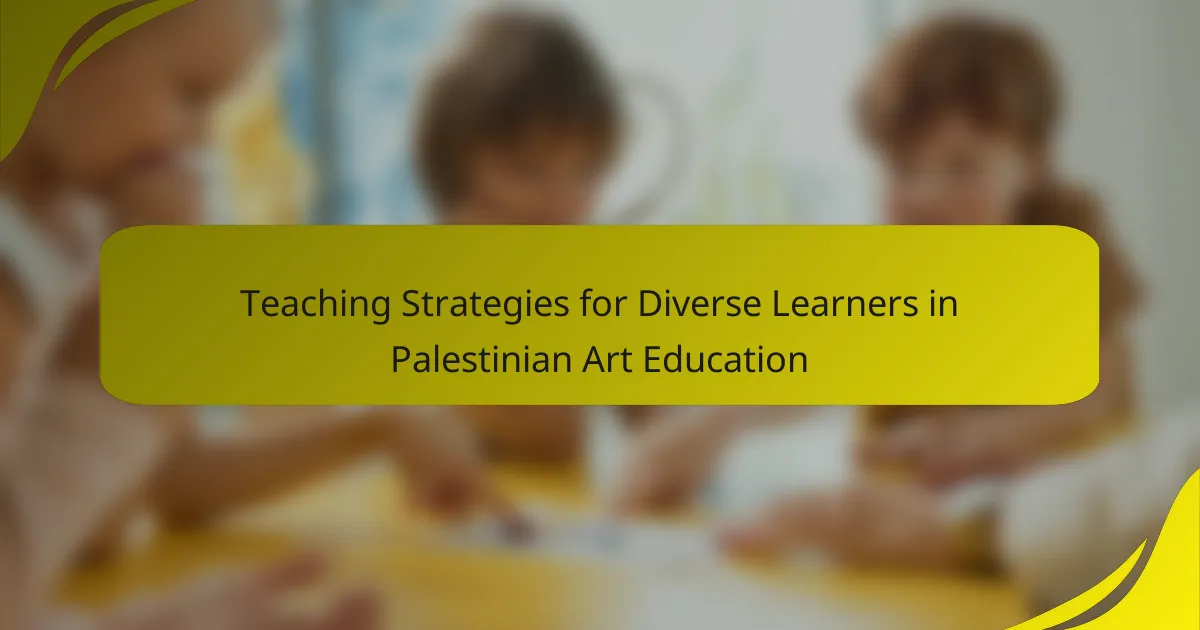Digital tools in art education refer to software and applications that enhance creative learning experiences for students and educators. This article explores the implementation of these tools in Palestinian art education, highlighting their role in improving creativity, accessibility, and student engagement. Key digital tools discussed include graphic design software, digital painting applications, and online collaboration platforms, which facilitate project management and peer feedback. The article also examines future trends, such as increased internet connectivity, virtual workshops, and the integration of augmented and virtual reality, which are expected to further enrich the art education landscape in Palestine. Research findings underscore the positive impact of these digital tools on artistic expression and cultural identity among Palestinian students.
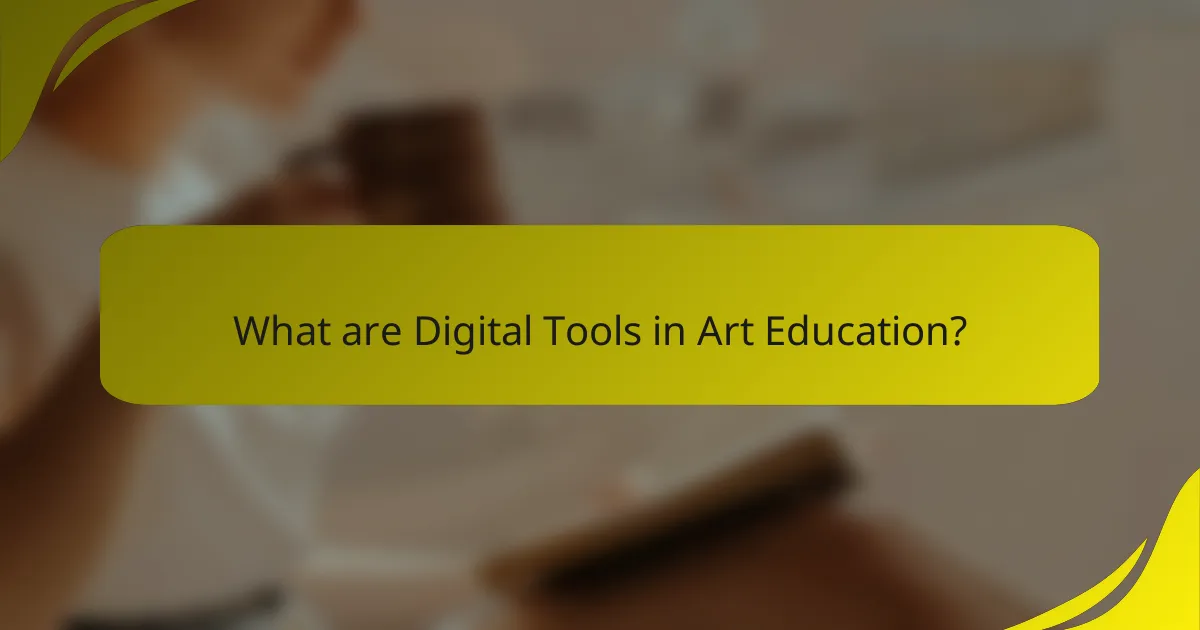
What are Digital Tools in Art Education?
Digital tools in art education are software and applications that facilitate creative learning. These tools include graphic design software, digital painting applications, and online collaboration platforms. They enhance students’ ability to create and share artwork. For instance, programs like Adobe Photoshop and Procreate allow for advanced digital art creation. Additionally, platforms such as Google Classroom support project management and peer feedback. Research shows that digital tools can improve engagement and accessibility in art education. A study by the National Art Education Association indicates that integrating technology fosters creativity and critical thinking in students.
How do digital tools enhance the learning experience in art education?
Digital tools enhance the learning experience in art education by providing interactive and accessible resources. These tools allow students to explore various artistic techniques through software and applications. For instance, programs like Adobe Creative Suite enable hands-on practice with digital design. Online platforms facilitate collaboration among students and teachers, promoting creative exchanges. Virtual reality can immerse students in art history and theory, making learning more engaging. Research indicates that technology integration in education improves student motivation and retention. A study by the National Art Education Association shows that digital tools can increase student engagement by 50%. This evidence supports the effectiveness of digital tools in enriching art education experiences.
What types of digital tools are commonly used in art education?
Digital tools commonly used in art education include graphic design software, digital drawing tablets, and online collaboration platforms. Graphic design software like Adobe Photoshop and Illustrator allows students to create and edit artwork digitally. Digital drawing tablets, such as Wacom, enable artists to draw directly onto a screen, enhancing their creative process. Online collaboration platforms, including Google Classroom and Padlet, facilitate sharing and feedback among students and teachers. These tools support various artistic techniques and encourage interactive learning. Studies show that integrating digital tools in art education enhances creativity and engagement among students.
How do these tools cater to different learning styles?
Digital tools cater to different learning styles by providing diverse methods of content delivery. Visual learners benefit from video tutorials and infographics. Auditory learners engage with podcasts and narrated presentations. Kinesthetic learners interact through hands-on activities and digital simulations. These tools allow for personalized learning experiences. Research shows that varied instructional methods enhance student engagement and retention. A study by Fleming and Mills identifies four distinct learning styles: visual, auditory, reading/writing, and kinesthetic. By incorporating various formats, digital tools effectively meet the needs of all learners.
What role do digital tools play in Palestinian art education specifically?
Digital tools play a significant role in Palestinian art education by enhancing accessibility and creativity. They provide platforms for students to explore various artistic techniques and mediums. Digital tools also facilitate collaboration among students and educators, allowing for the sharing of ideas and feedback. Furthermore, they enable access to global art resources and online tutorials, broadening students’ artistic perspectives. The integration of software like Adobe Creative Suite is common in curricula, teaching essential digital art skills. Additionally, virtual galleries and online exhibitions allow students to showcase their work beyond local boundaries. This exposure can lead to increased opportunities in the art world. Overall, digital tools empower Palestinian artists to express their culture and experiences in innovative ways.
How can digital tools help preserve and promote Palestinian culture through art?
Digital tools can help preserve and promote Palestinian culture through art by facilitating access to cultural resources. They enable artists to share their work globally, increasing visibility for Palestinian art. Platforms like social media allow for real-time engagement with audiences. Digital archives can preserve traditional art forms and techniques for future generations. Online workshops can educate participants about Palestinian art history and practices. Virtual reality can recreate significant cultural sites, enhancing appreciation for Palestinian heritage. Data shows that increased online presence leads to greater cultural awareness and support.
What challenges do Palestinian art educators face in integrating digital tools?
Palestinian art educators face several challenges in integrating digital tools. Limited access to technology is a primary issue. Many schools lack the necessary hardware and software for digital art education. Additionally, unstable internet connectivity hampers effective online learning and resource access. There is also a lack of training for educators in using digital tools effectively. Many teachers are not familiar with the latest digital art techniques. Cultural and political factors further complicate the integration of digital tools in classrooms. These challenges hinder the ability to provide a comprehensive art education that includes digital mediums.
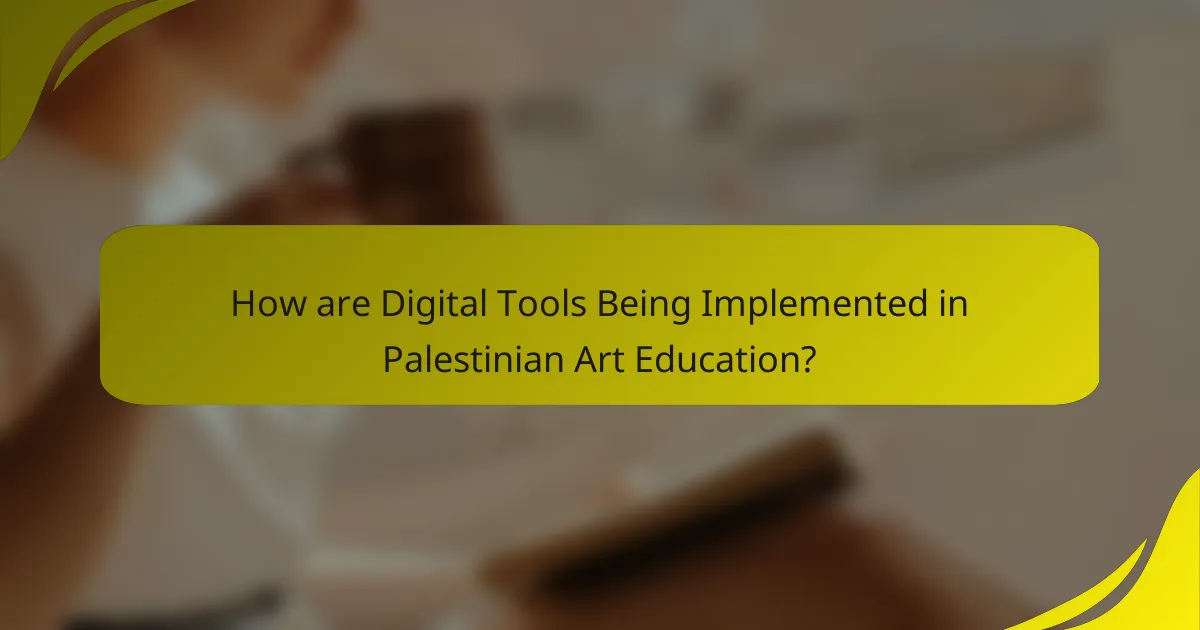
How are Digital Tools Being Implemented in Palestinian Art Education?
Digital tools are being implemented in Palestinian art education through various platforms and technologies. These tools enhance creativity and accessibility for students and educators. Online courses and digital workshops provide learning opportunities beyond traditional classrooms. Virtual galleries allow artists to showcase their work to a global audience. Social media platforms facilitate community engagement and collaboration among artists. Mobile applications are used for art creation and sharing. Research indicates that these digital tools improve student engagement and skill development. For example, a study by Al-Qattan (2021) highlights how digital art programs in Palestine foster artistic expression and cultural identity.
What are some successful case studies of digital tool usage in Palestinian art education?
There are several successful case studies of digital tool usage in Palestinian art education. One notable example is the “Art and Technology” program initiated by the Al-Quds University. This program integrates digital media into traditional art curricula. Students engage in workshops that utilize software like Adobe Photoshop and Illustrator. This enhances their skills in graphic design and digital illustration.
Another case study involves the “Digital Storytelling” project by the Palestinian Art Academy. This project encourages students to create multimedia narratives. They use tools such as video editing software and digital photography. This approach fosters creativity and improves technical skills among participants.
Additionally, the “Virtual Art Gallery” initiative by the University of Bethlehem showcases student artworks online. This platform allows for wider audience engagement and feedback. It also provides students with exposure to international art communities.
These case studies demonstrate the effective integration of digital tools in Palestinian art education. They enhance learning experiences and expand opportunities for artistic expression.
What specific tools were used in these case studies?
The specific tools used in these case studies include digital platforms like Zoom and Google Classroom. Zoom facilitated live interactions and discussions among participants. Google Classroom served as a hub for sharing resources and assignments. Additionally, tools like Canva were utilized for creating visual content. Social media platforms, such as Instagram, were used for showcasing art and engaging with a broader audience. These tools collectively enhanced the learning experience and accessibility of art education for Palestinian students.
What outcomes were achieved through the implementation of these tools?
The implementation of digital tools in Palestinian art education achieved enhanced engagement among students. Students demonstrated increased creativity and collaboration through online platforms. The tools facilitated access to diverse art resources and global art communities. Teachers reported improved student motivation and participation in art projects. Additionally, the integration of technology allowed for innovative teaching methods. Evidence shows that students produced higher-quality artwork using digital mediums. Overall, these outcomes reflect a positive transformation in the educational experience.
How can educators effectively incorporate digital tools into their curriculum?
Educators can effectively incorporate digital tools into their curriculum by integrating technology that enhances learning experiences. They should select tools that align with educational objectives. For instance, platforms like Google Classroom facilitate organization and communication. Interactive software, such as Kahoot!, engages students through quizzes and games. Multimedia resources, including videos and podcasts, enrich content delivery. Training sessions for educators on digital tools can improve implementation. Research shows that technology integration can increase student engagement by up to 30%. Additionally, feedback mechanisms through digital tools allow for real-time assessment of student understanding.
What strategies can teachers use to engage students with digital art tools?
Teachers can engage students with digital art tools by integrating interactive and collaborative projects. Utilizing platforms like digital sketch pads encourages creativity. Assignments that involve peer feedback foster a sense of community. Incorporating gamified elements can increase motivation and participation. Providing tutorials on specific tools helps students build confidence. Showcasing student work in a virtual gallery promotes pride in their creations. Encouraging exploration of diverse digital mediums enhances artistic skills. Regularly updating tools and resources keeps the learning experience fresh and relevant.
What resources are available for educators to learn about digital tools?
Educators can access various resources to learn about digital tools. Online platforms like Coursera and edX offer courses specifically for educators. Websites such as Edutopia provide articles and guides on integrating technology in the classroom. YouTube hosts numerous tutorials on using specific digital tools effectively. Professional development workshops often focus on digital literacy for educators. Additionally, educational blogs and forums allow teachers to share experiences and tips. Many universities also offer programs on digital education. Research indicates that ongoing training significantly improves educators’ digital competencies.
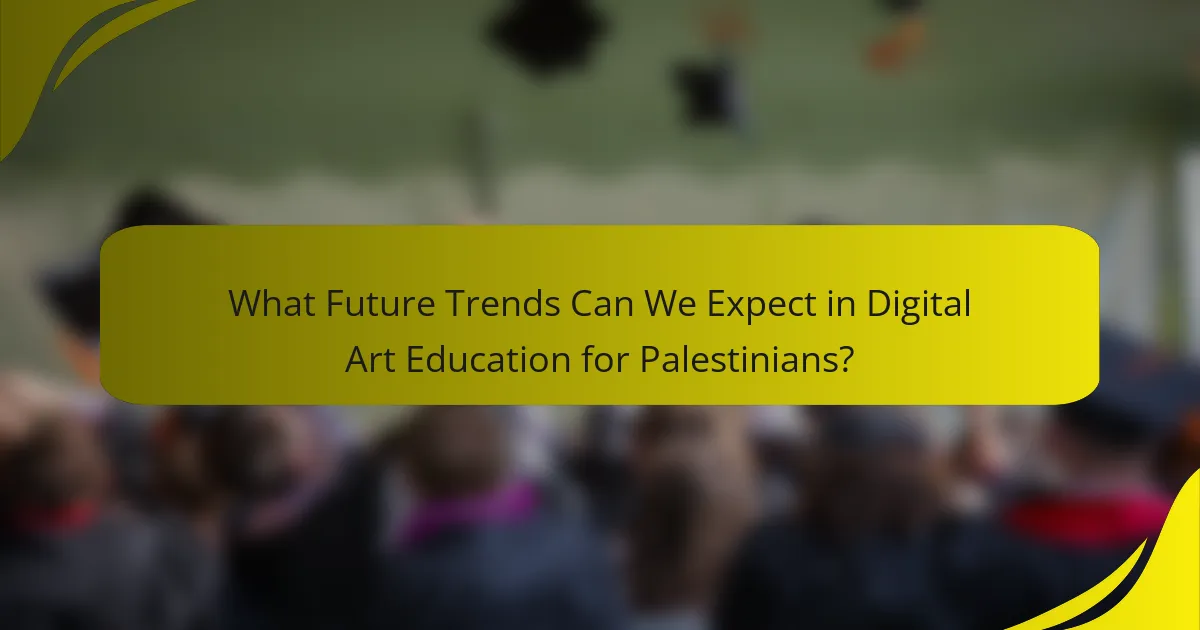
What Future Trends Can We Expect in Digital Art Education for Palestinians?
Future trends in digital art education for Palestinians include increased access to online platforms and resources. The growth of internet connectivity in the region enables more students to engage with digital art tools. Virtual workshops and webinars are becoming popular, allowing artists to learn from global experts. Collaborative projects using digital media are expected to rise, fostering community engagement and creativity. Mobile applications for art creation are likely to gain traction, making art education more accessible. Integration of augmented reality (AR) and virtual reality (VR) in art projects can enhance interactive learning experiences. Furthermore, educational institutions may adopt blended learning models, combining online and offline methods to enrich the curriculum. These trends reflect a shift towards embracing technology to empower Palestinian artists and educators.
How is technology evolving in the context of art education?
Technology is evolving in art education through the integration of digital tools and platforms. These advancements enable interactive learning experiences for students. Virtual reality (VR) and augmented reality (AR) are used to create immersive environments for art exploration. Online platforms facilitate collaboration among artists and educators across geographical boundaries. Digital software allows for diverse forms of artistic expression, such as digital painting and animation. Additionally, social media serves as a platform for showcasing student artwork. Research indicates that technology enhances engagement and creativity in art education. For instance, a study by the National Art Education Association highlights increased student motivation when using digital tools in the classroom.
What emerging digital tools show promise for enhancing art education?
Emerging digital tools enhancing art education include virtual reality (VR), augmented reality (AR), and online collaborative platforms. VR allows students to immerse themselves in 3D art environments. This technology can simulate art history experiences, making learning interactive. AR overlays digital information onto the real world. It can enhance traditional art lessons by providing additional context. Online collaborative platforms enable students to share and critique artwork globally. These tools foster community and feedback in real-time. According to a study by the International Society for Technology in Education, integrating technology in art education increases engagement and creativity.
How can educators prepare for future advancements in digital tools?
Educators can prepare for future advancements in digital tools by engaging in continuous professional development. This includes attending workshops and training sessions focused on emerging technologies. Educators should also collaborate with tech experts to understand new tools. Incorporating digital literacy into the curriculum is essential. This prepares students for a tech-driven future. Furthermore, educators can experiment with pilot programs to test new tools. Staying informed about trends in educational technology is crucial. Research indicates that schools adopting innovative tools see improved student engagement and learning outcomes.
What best practices should educators follow when using digital tools in art education?
Educators should prioritize student engagement when using digital tools in art education. Engaging students enhances their motivation and creativity. Incorporating interactive software can facilitate this engagement. Tools like digital sketchpads allow for real-time feedback and collaboration. Educators should also ensure accessibility for all students. This includes providing alternative formats for digital content. Training educators on the effective use of these tools is essential. Professional development can improve their confidence and skills. Lastly, integrating digital tools with traditional methods can create a balanced learning experience. This approach fosters a comprehensive understanding of art practices.
What common pitfalls should educators avoid when implementing digital tools?
Educators should avoid several common pitfalls when implementing digital tools. One major pitfall is the lack of proper training for both educators and students. Research indicates that insufficient training can lead to ineffective use of technology in the classroom. Another common mistake is neglecting to align digital tools with educational objectives. Tools should enhance learning outcomes, not distract from them. Additionally, educators often overlook the importance of student engagement. Tools that fail to engage students can result in lower motivation and participation.
Another pitfall is ignoring the digital divide. Not all students have equal access to technology, which can create disparities in learning opportunities. Furthermore, educators sometimes underestimate the time required for integrating digital tools into the curriculum. A rushed implementation can lead to confusion and frustration among students. Lastly, failing to assess the effectiveness of the digital tools used can prevent continuous improvement. Regular evaluation is crucial for ensuring that the tools meet educational needs.
How can educators evaluate the effectiveness of digital tools in their teaching?
Educators can evaluate the effectiveness of digital tools in their teaching by assessing student engagement and learning outcomes. They should track student participation levels during digital tool usage. Surveys and feedback forms can provide insights into student satisfaction. Comparing test scores before and after implementing digital tools can reveal their impact on learning. Observing changes in student collaboration and creativity is also crucial. Additionally, educators can analyze how well digital tools align with curriculum objectives. Research indicates that effective digital tools enhance student motivation and achievement, supporting their evaluation.
Digital tools in art education are software and applications that enhance creative learning experiences for students, particularly in the context of Palestinian art education. This article explores how these tools, including graphic design software and online collaboration platforms, improve engagement, creativity, and accessibility in art education. It discusses the various types of digital tools commonly used, their impact on different learning styles, and specific challenges faced by Palestinian educators in integrating these technologies. Additionally, the article highlights successful case studies and future trends in digital art education, emphasizing the importance of technology in preserving and promoting Palestinian culture through art.
